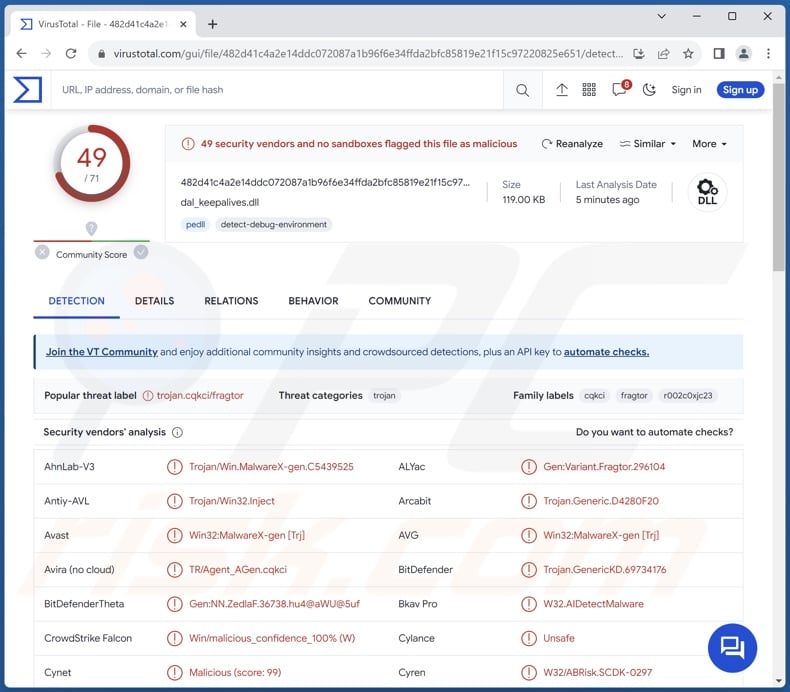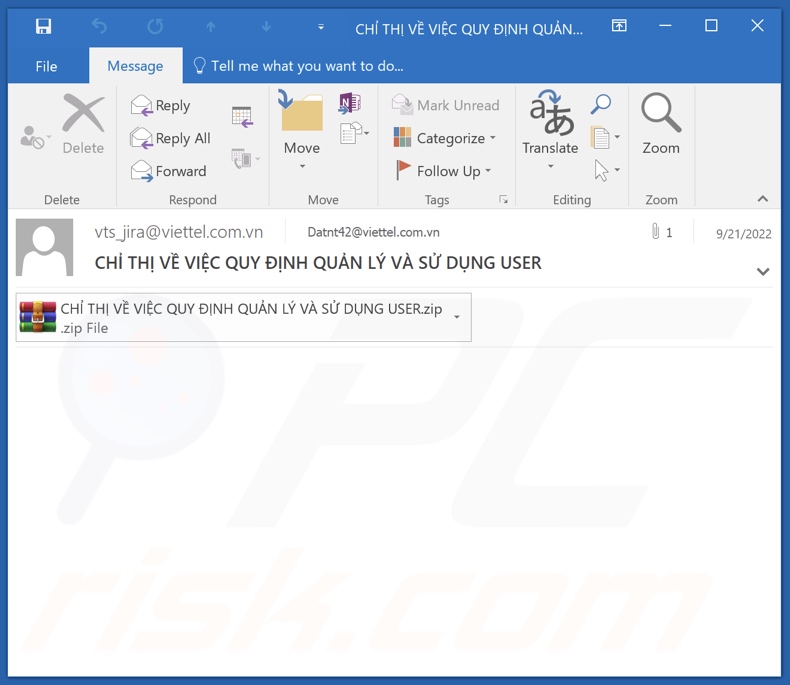Removal instructions for programs belonging to the Cur malware group
![]() Written by Tomas Meskauskas on (updated)
Written by Tomas Meskauskas on (updated)
What is Cur malware group?
Cur malware group refers to a family of malicious programs. The software belonging to this group share little commonality with each other, likewise there are no evident code similarities. What links these programs to one another is a shared infrastructure, and there is evidence suggesting that it is connected to a cyber-espionage group affiliated with China – called ToddyCat.
At the time of writing, the Cur malware family is actively used in a campaign dubbed "Stayin' Alive", which has been going on since at least 2021. This operation is active in Asia – namely, Kazakhstan, Uzbekistan, Pakistan, and Vietnam. The known attacks targeted the telecommunications sphere and entities linked to governmental bodies.

Cur malware group overview
The Cur malware group consists of backdoors and loaders – types of programs that prep systems for further infiltration and infect them with additional malicious software. Programs that are part of this family are custom-built for targeted attacks. They are simplistic and tend to be lightweight (small in size).
Evidence suggests that these programs are intended to be easily disposable, as they are highly specialized and do not boast significant versatility.
The majority of known Cur infections originate from targeted spam mail and rely on the DLL side-loading technique to infiltrate machines. This method entails using the Windows DLL search order mechanism to leverage legitimate software that executes a malicious payload.
CurKeep – is a backdoor. Like most programs of this group, it is extremely lightweight – 10KB in size. Once this malware establishes itself, it sends base device data to its C&C (Command and Control) server. Afterward, the malware waits to receive commands.
CurKeep is proliferated via malspam. The targeted spam emails include archives containing a legitimate program executable that uses DLL side-loading to introduce CurKeep into the system.
One spam campaign that took place in September 2022 was leveraged against a Vietnamese telecommunications company. The archive attached to this spam email was titled "CHỈ THỊ VỀ VIỆC QUY ĐỊNH QUẢN LÝ VÀ SỬ DỤNG USER.zip", which very roughly translates to – "Instructions on user management and use regulations.zip".
CurKeep was carried by other archives:
- "QForm V8.zip" – naming QForm – a professional engineering software used for simulation of metal forming processes;
- "Саммит 2022 г (парол - 0809).rar" – translating as "Summit 2022 (password – 0809).rar", and while the text is in Russian the file was submitted from Uzbekistan;
- "Приказ №83 от 29.05.2023г.rar" – translating as "Order No. 83 from 29/05/2023.rar" [order – meaning command/instruction; DD/MM/YYYY date format], likewise in Russian but originating from Kazakhstan.
CurLu – is a loader. This program's purpose is to retrieve payloads from its C&C server. CurLu was most commonly noted in use through the "Stayin' Alive" campaign. Most of the infections relied on the DLL side-loading technique, but not exclusively.
CurLog – is a loader, likewise designed to download/install a payload. There are several variants of CurLog. As most Cur programs, it is distributed via DLL side-loading, an example being an archive titled "Compatible Products - Vector ver7.1.1.zip" containing an executable with the same filename. The ZIP archive in question was submitted from Kazakhstan.
However, this malware has been spread using other techniques as well. The oldest known CurLog version was distributed through an ISO image targeting a Vietnamese ISP (Internet Service Provider).
CurCore – is another lightweight backdoor. It is likely used for initial reconnaissance and payload delivery. CurCore can read and create files, as well as copy their contents. Hence, this malware is capable of reading files and writing their data into new ones, encoding the information, and then sending it to the C&C server. CurCore can also receive commands and execute them.
Threats associated with an infection depend on the malware's capabilities and the cyber criminals' modus operandi. The Cur malware family consists of loaders and backdoors, the types of programs typically used in the initial stages of an attack. This leaves room for variation, especially considering that this malware is custom-made and utilized in heavily targeted attacks.
Generally, high-risk infections can result in decreased system performance or failure, data loss, severe privacy issues, financial losses, and identity theft. The dangers are even greater when malware is leveraged against highly sensitive entities, which is true of the Cur group.
| Name | Cur malware family |
| Threat Type | Trojan, backdoor, loader. |
| Detection Names (CurKeep) | Avast (Win32:MalwareX-gen [Trj]), Combo Cleaner (Trojan.GenericKD.69734176), ESET-NOD32 (A Variant Of Win32/Agent_AGen.BAN), Kaspersky (HEUR:Trojan.Win32.Inject.gen), Microsoft (Trojan:Win32/Injector!MSR), Full List Of Detections (VirusTotal) |
| Detection Names (CurLu) | Avast (Win32:Trojan-gen), Combo Cleaner (Trojan.GenericKD.69734180), ESET-NOD32 (A Variant Of Win32/TrojanDownloader.Sp), Malwarebytes (Malware.AI.1962469087), Microsoft (Trojan:Win32/Injector!MSR), Full List Of Detections (VirusTotal) |
| Detection Names (CurLog) | Avast (Win32:TrojanX-gen [Trj]), Combo Cleaner (Trojan.GenericKD.69734198), ESET-NOD32 (Win32/Agent.AEHU), Kaspersky (VHO:Trojan.Win32.Dllhijack.gen), Microsoft (Trojan:Win32/Injector!MSR), Full List Of Detections (VirusTotal) |
| Detection Names (CurCore) | Avast (Win32:Trojan-gen), Combo Cleaner (Trojan.GenericKD.65948378), ESET-NOD32 (A Variant Of Win32/ShellcodeRunner.DA), Kaspersky (Trojan-Dropper.Win32.Agent.tewdhz), Microsoft (Trojan:Win32/Injector!MSR), Full List Of Detections (VirusTotal) |
| Symptoms | Trojans are designed to stealthily infiltrate the victim's computer and remain silent, and thus no particular symptoms are clearly visible on an infected machine. |
| Distribution methods | Infected email attachments, malicious online advertisements, social engineering, software 'cracks'. |
| Damage | Stolen passwords and banking information, identity theft, the victim's computer added to a botnet. |
| Malware Removal (Windows) | To eliminate possible malware infections, scan your computer with legitimate antivirus software. Our security researchers recommend using Combo Cleaner. |
Malware in general
We have researched thousands of malware samples; qBit, GhostLocker, Millenium, SysUpdate, and BunnyLoader are just some of our newest articles on this topic.
While some malicious programs, like those belonging to the Cur malware family, serve narrowly tailored purposes – others can be incredibly versatile. Malware can be designed to cause infection chains, spy, steal information, encrypt data for ransom purposes (ransomware), and so on.
However, regardless of how malicious software operates – its presence on a system threatens device integrity and user safety. Therefore, all threats must be eliminated immediately upon detection.
How did Cur malware infiltrate my computer?
Cur malware has been actively distributed via malspam. These spam emails are heavily targeted and include archive file attachments. The archives usually contain legitimate software executables that use the DLL side-loading technique to deliver Cur malware. An archive delivering one of the Cur programs (CurKeep) had been hosted in a portal used by researchers.
These programs could be proliferated using other file types or methods. Malicious files come in various formats; aside from archives (ZIP, RAR, etc.), they can be executables (.exe, .run, etc.), documents (PDF, Microsoft Office, Microsoft OneNote, etc.), JavaScript, and so on.
To expand upon malware distribution in general terms, phishing and social engineering techniques are exceptionally prevalent.
Common proliferation methods include: malicious attachments/links in spam mail (e.g., emails, PMs/DMs, SMSes, etc.), drive-by (stealthy/deceptive) downloads, untrustworthy download sources (e.g., freeware and free file-hosting websites, Peer-to-Peer sharing networks, etc.), online scams, malvertising, illegal software activation tools ("cracks"), and fake updates.
What is more, some malicious programs can self-spread via local networks and removable storage devices (e.g., external hard drives, USB flash drives, etc.).
How to avoid installation of malware?
It is essential to exercise caution with incoming emails and other messages. Attachments or links present in suspicious/irrelevant mail must not be open, as they can be infectious. Caution must be extended to browsing since fraudulent and malicious online content usually appears genuine and innocuous.
Furthermore, all downloads must be performed from official and verified channels. We advise activating and updating software by using legitimate functions/tools, as those obtained from third-parties may contain malware.
It is paramount for device and user safety to have a reputable anti-virus installed and kept up-to-date. Security programs must be used to run regular system scans and to remove threats and issues. If you believe that your computer is already infected, we recommend running a scan with Combo Cleaner Antivirus for Windows to automatically eliminate infiltrated malware.
Screenshot of a spam email used to distribute CurKeep ("CHỈ THỊ VỀ VIỆC QUY ĐỊNH QUẢN LÝ VÀ SỬ DỤNG USER.zip"):

Instant automatic malware removal:
Manual threat removal might be a lengthy and complicated process that requires advanced IT skills. Combo Cleaner is a professional automatic malware removal tool that is recommended to get rid of malware. Download it by clicking the button below:
▼ DOWNLOAD Combo Cleaner
By downloading any software listed on this website you agree to our Privacy Policy and Terms of Use. To use full-featured product, you have to purchase a license for Combo Cleaner. 7 days free trial available. Combo Cleaner is owned and operated by Rcs Lt, the parent company of PCRisk.com read more.
Quick menu:
- What is Cur malware group?
- STEP 1. Manual removal of Cur malware.
- STEP 2. Check if your computer is clean.
How to remove malware manually?
Manual malware removal is a complicated task - usually it is best to allow antivirus or anti-malware programs to do this automatically. To remove this malware we recommend using Combo Cleaner Antivirus for Windows.
If you wish to remove malware manually, the first step is to identify the name of the malware that you are trying to remove. Here is an example of a suspicious program running on a user's computer:

If you checked the list of programs running on your computer, for example, using task manager, and identified a program that looks suspicious, you should continue with these steps:
 Download a program called Autoruns. This program shows auto-start applications, Registry, and file system locations:
Download a program called Autoruns. This program shows auto-start applications, Registry, and file system locations:

 Restart your computer into Safe Mode:
Restart your computer into Safe Mode:
Windows XP and Windows 7 users: Start your computer in Safe Mode. Click Start, click Shut Down, click Restart, click OK. During your computer start process, press the F8 key on your keyboard multiple times until you see the Windows Advanced Option menu, and then select Safe Mode with Networking from the list.

Video showing how to start Windows 7 in "Safe Mode with Networking":
Windows 8 users: Start Windows 8 is Safe Mode with Networking - Go to Windows 8 Start Screen, type Advanced, in the search results select Settings. Click Advanced startup options, in the opened "General PC Settings" window, select Advanced startup.
Click the "Restart now" button. Your computer will now restart into the "Advanced Startup options menu". Click the "Troubleshoot" button, and then click the "Advanced options" button. In the advanced option screen, click "Startup settings".
Click the "Restart" button. Your PC will restart into the Startup Settings screen. Press F5 to boot in Safe Mode with Networking.

Video showing how to start Windows 8 in "Safe Mode with Networking":
Windows 10 users: Click the Windows logo and select the Power icon. In the opened menu click "Restart" while holding "Shift" button on your keyboard. In the "choose an option" window click on the "Troubleshoot", next select "Advanced options".
In the advanced options menu select "Startup Settings" and click on the "Restart" button. In the following window you should click the "F5" button on your keyboard. This will restart your operating system in safe mode with networking.

Video showing how to start Windows 10 in "Safe Mode with Networking":
 Extract the downloaded archive and run the Autoruns.exe file.
Extract the downloaded archive and run the Autoruns.exe file.

 In the Autoruns application, click "Options" at the top and uncheck "Hide Empty Locations" and "Hide Windows Entries" options. After this procedure, click the "Refresh" icon.
In the Autoruns application, click "Options" at the top and uncheck "Hide Empty Locations" and "Hide Windows Entries" options. After this procedure, click the "Refresh" icon.

 Check the list provided by the Autoruns application and locate the malware file that you want to eliminate.
Check the list provided by the Autoruns application and locate the malware file that you want to eliminate.
You should write down its full path and name. Note that some malware hides process names under legitimate Windows process names. At this stage, it is very important to avoid removing system files. After you locate the suspicious program you wish to remove, right click your mouse over its name and choose "Delete".

After removing the malware through the Autoruns application (this ensures that the malware will not run automatically on the next system startup), you should search for the malware name on your computer. Be sure to enable hidden files and folders before proceeding. If you find the filename of the malware, be sure to remove it.

Reboot your computer in normal mode. Following these steps should remove any malware from your computer. Note that manual threat removal requires advanced computer skills. If you do not have these skills, leave malware removal to antivirus and anti-malware programs.
These steps might not work with advanced malware infections. As always it is best to prevent infection than try to remove malware later. To keep your computer safe, install the latest operating system updates and use antivirus software. To be sure your computer is free of malware infections, we recommend scanning it with Combo Cleaner Antivirus for Windows.
Frequently Asked Questions (FAQ)
My computer is infected with Cur malware, should I format my storage device to get rid of it?
Most malicious programs can be removed without resorting to formatting.
What are the biggest issues that Cur malware can cause?
The dangers linked to an infection depend on the malware's functionalities and the attackers' goals. Programs belonging to the Cur malware group include backdoors and loaders – which are designed to prepare systems for further infections and carry them out.
In general, high-risk infections can lead to serious privacy issues, financial losses, and identity theft. However, Cur malware is custom-made for targeted attacks against sensitive entities – therefore, the consequences of these infections can be significantly more dire.
What is the purpose of Cur malware?
Malware is primarily used to generate revenue. Other purposes include amusing the attackers, carrying out personal vendettas, disrupting processes (e.g., websites, services, companies, etc.), engaging in hacktivism, and launching politically/geopolitically motivated attacks.
The Cur malware family is linked to a Chinese cyber-espionage group – called ToddyCat. These programs have been used in campaigns targeting the telecommunications sector and governmental entities. The targets were located in Kazakhstan, Uzbekistan, Vietnam, and Pakistan.
How did Cur malware infiltrate my computer?
Cur malware group has been predominantly spread through targeted spam emails. However, other methods are not unlikely.
Generally, malware is distributed via spam, drive-by downloads, online scams, malvertising, dubious download sources (e.g., unofficial and free file-hosting sites, P2P sharing networks, etc.), illegal software activation ("cracking") tools, and fake updates. Furthermore, some malicious programs can self-proliferate through local networks and removable storage devices.
Will Combo Cleaner protect me from malware?
Yes, Combo Cleaner is capable of detecting and eliminating nearly all known malware infections. It must be emphasized that since sophisticated malicious software usually hides deep within systems – performing a full system scan is crucial.


▼ Show Discussion